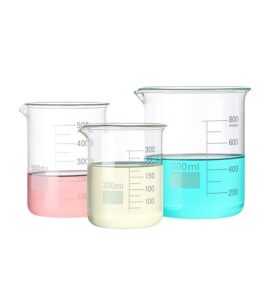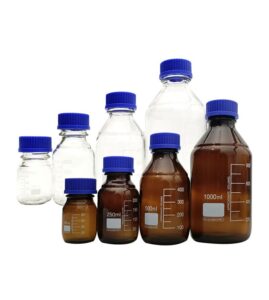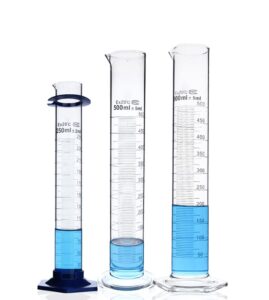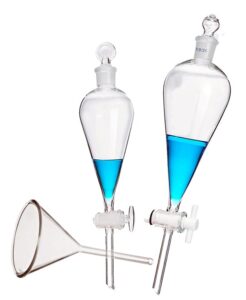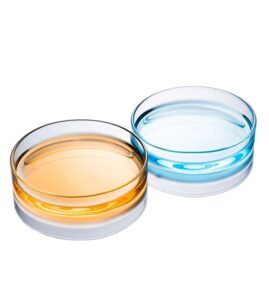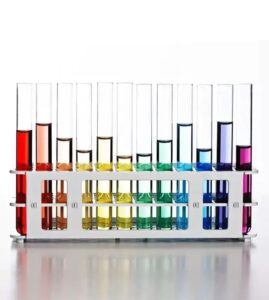Have you ever found yourself puzzled over which glassware to use for your chemical experiments? Does the myriad of options leave you bewildered, affecting the accuracy and safety of your reactions? It’s a common dilemma for many, from students in a chemistry lab to professional scientists.
Selecting the appropriate glassware for chemical reactions is not just about aesthetics or what’s readily available; it involves understanding the nature of the reaction, the properties of the reactants, and the requirements of the process. This guide aims to shed light on this decision-making process, ensuring that your chemical reactions are both safe and effective.
Let’s dive deeper into the world of chemical glassware and explore how to make the right choice for your experiments.

Understanding the Basics of Chemical Glassware
When diving into the world of chemistry, whether in an academic, professional, or hobbyist setting, the importance of the right glassware cannot be overstated. It’s not just about having a container to mix your chemicals; it’s about understanding the role that each piece of glassware plays in ensuring accurate, safe, and successful chemical reactions. Let’s explore the foundational aspects of chemical glassware.
1. Material Matters
The material of the glassware is a critical factor that can significantly affect the outcome of a chemical reaction. Here are some key points:
- Borosilicate Glass: This is a popular choice in laboratories due to its excellent resistance to thermal shock and chemical corrosion. It can withstand high temperatures and aggressive chemicals, making it suitable for a wide range of reactions.
- Quartz Glass: Known for its exceptional purity and resistance to high temperatures, quartz glass is ideal for specialized applications, such as UV spectroscopy or operations involving extreme heat.
- Soda-Lime Glass: More common in educational settings or for less intense chemical handling, soda-lime glass is economical but less resistant to thermal shock and chemicals compared to borosilicate glass.
2. Shape and Size: More Than Just Geometry
The shape and size of glassware are designed to serve specific purposes in chemical reactions:
- Beakers and Flasks: These are used for mixing, heating, and storing chemical solutions. Beakers have a wide opening and are generally used for rough measurements, while flasks, with their narrow necks, are better for containing reactions or for more precise volume measurements.
- Test Tubes: Ideal for small-scale experiments, test tubes facilitate easy handling and heating of substances. Their cylindrical shape is perfect for observing reactions.
- Volumetric Flasks: These are essential for preparing solutions with precise concentrations, as they are calibrated for a single volume.
3. Essential Glassware for Chemical Reactions
To conduct chemical reactions effectively, certain types of glassware are indispensable:
- Beakers: These are versatile glass containers with a wide opening and flat bottom, ideal for mixing, heating, and pouring chemical solutions. They are commonly used for general mixing and rough measurements due to their simple design.
- Flasks: Including Erlenmeyer flasks and Florence (round-bottom) flasks, these containers are used for mixing and heating chemicals. Erlenmeyer flasks have a conical shape with a wide base that tapers to a narrow neck, making them stable and good for swirling liquids without risk of spillage. Florence flasks are round, enhancing even heating and are often used in distillation processes.
- Test Tubes: Small cylindrical tubes used for holding, mixing, and heating small amounts of liquids. They are essential for small-scale reactions and are convenient for observing changes during reactions.
- Reagent Bottles: Used for storing chemicals, reagent bottles come in various sizes and often have specific types of stoppers to prevent contamination and preserve the contents.
- Evaporating Dishes: Shallow dishes used for the evaporation of liquids to leave behind a solid residue. They are particularly useful in crystallization processes.
- Alcohol Burners: A source of heat in many laboratory settings, alcohol burners are used for heating chemicals. They provide a more controlled flame compared to other heat sources.
- Glass Rods: These are used for stirring mixtures or for facilitating the transfer of liquids between containers. They are simple yet essential tools in a laboratory.
- Graduated Cylinders: These are cylindrical containers used for accurately measuring the volume of liquids. They are more precise than beakers and are marked with volume graduations.
- Condensers: Used primarily in distillation processes, they cool down vapors and convert them back into liquid. This is crucial for the separation of mixtures based on boiling points.
- Burettes: These are long, cylindrical tubes with a valve at the bottom, used for dispensing known volumes of a liquid, especially in titrations. They allow for precise control and measurement of liquid volumes.
Understanding these basics of chemical glassware is the first step towards conducting safe and successful experiments. The right glassware not only ensures accuracy but also enhances the efficiency and safety of your chemical operations.
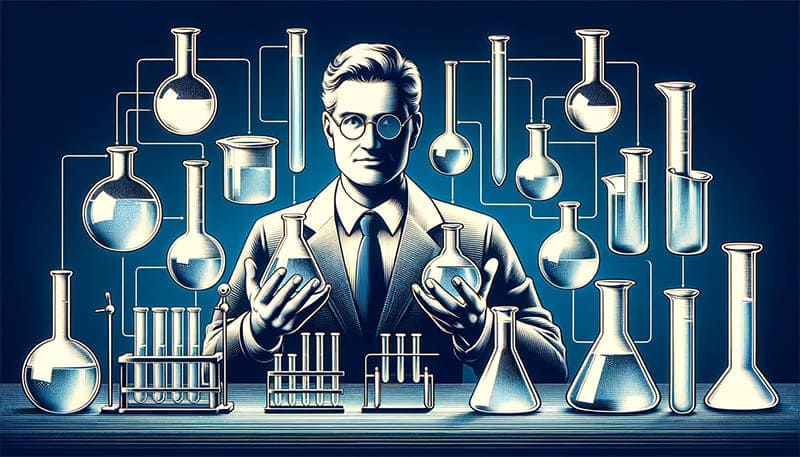
Choosing the Right Glassware for Chemical Reactions
In chemical reactions, it is very important to select the appropriate glassware for the reaction. Glassware has several advantages, such as corrosion resistance, high transparency, and ease of observing the reaction process. However, different glassware has different properties and ranges of use, so it is necessary to choose the right glassware based on the specific requirements and conditions of the reaction.
1. Selection of Laboratory Glassware
Laboratory glassware is used to hold reactants and conduct chemical reactions. Common types of glassware include beakers, flasks, conical flasks, reagent bottles, volumetric flasks, and test tubes. When choosing glassware, consider the following:
- Material: Glass is a common material in chemical experiments, known for its corrosion resistance, high transparency, and ease of cleaning. However, different chemical reactions may require different types of glass materials, such as borosilicate glass or quartz glass. Therefore, the appropriate glass material should be selected based on the specific requirements and conditions of the reaction.
- Shape and Size: Different reactions require different shapes and sizes of containers. For example, reactions that require stirring might need beakers or flasks with stirrers; reactions that involve gas absorption or emission might need conical flasks or test tubes with gas guide tubes. Also, the capacity of the container should be chosen based on the amount of reactants and the requirements of the reaction.
- Sealing: In some chemical reactions, it is necessary to seal the reaction container to prevent the escape of gases or liquids. Therefore, when choosing a reaction container, the sealing performance and quality of the sealing components should be considered.
2. Selection of Adding Devices
Adding devices are used to add reactants into glassware. Common adding devices include burettes, volumetric flasks, and funnels. When choosing an adding device, consider the following:
- Material of the Device: The material of the adding device should be chosen based on the nature and requirements of the reactants being added. For example, if corrosive substances need to be added, materials like polytetrafluoroethylene (PTFE) that are corrosion-resistant should be used.
- Capacity of the Device: The capacity of the adding device should be based on the amount of reactant being added and the requirements. For example, if a large volume of liquid needs to be added, larger burettes or volumetric flasks should be chosen.
- Connection Method of the Device: The adding device needs to be connected to the reaction container to add the reactants. Therefore, the connection method and sealing performance of the adding device should be noted.
3. Selection of Cooling Devices
Cooling devices are used to remove heat from the chemical reaction process to maintain a constant reaction temperature. Common cooling devices include condenser tubes, ice baths, and chillers. When choosing a cooling device, consider the following:
- Cooling Capacity: The cooling capacity of the device should be selected based on the amount of heat generated during the chemical reaction process and the requirements. For example, if rapid cooling of the reactants is needed, a condenser or chiller with strong cooling capacity should be chosen.
- Material: The material of the cooling device should be chosen based on the type of cooling medium and requirements. For example, if water is used as a cooling medium, copper or stainless steel condenser tubes or cooling coils can be chosen.
- Connection Method: The cooling device needs to be connected to the reaction container to remove heat. Therefore, the connection method and sealing performance of the cooling device should be considered.
Choosing the right glassware in chemical reactions requires comprehensive consideration based on the specific requirements and conditions of the reaction. It is necessary to consider the material, shape, size, and sealing of the reaction container, as well as the choice and usage method of adding devices and cooling devices. Only by selecting the appropriate glassware can the smooth progress of chemical reactions and the reliability of experimental results be ensured.
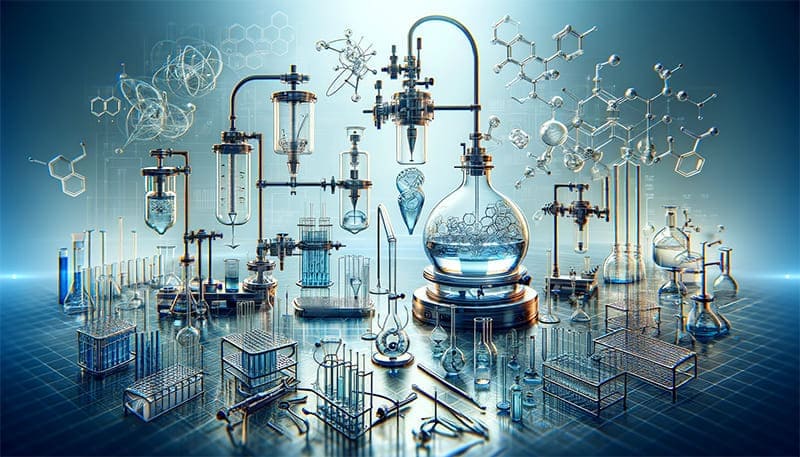
Advanced Considerations in Glassware Selection
Temperature Control in Reactions
For reactions sensitive to temperature fluctuations, choose glassware that can withstand sudden temperature changes. Borosilicate glassware is often preferred for its low thermal expansion rate. For extreme temperatures, quartz glassware is the go-to choice, capable of enduring intense heat without damage.
Chemical Reactivity and Compatibility
Certain chemicals can react with glass. For instance, hydrofluoric acid is known to etch glass. In such cases, using polytetrafluoroethylene (PTFE) or other non-glass alternatives is recommended. Always consider the chemical compatibility of your glassware with the reactants used.
Scale of the Reaction: Microscale vs. Macroscale
- Microscale reactions require small-sized glassware to minimize waste and enhance safety. Test tubes and microscale flasks are ideal.
- Macroscale reactions often call for larger glassware like large beakers or round-bottom flasks to handle greater volumes of reactants.
Sealing and Evaporation
For reactions where evaporation is a concern or where an inert atmosphere is needed, glassware with ground glass joints and stoppers is essential. This ensures a tight seal, preventing the escape of reactants or the entry of contaminants.
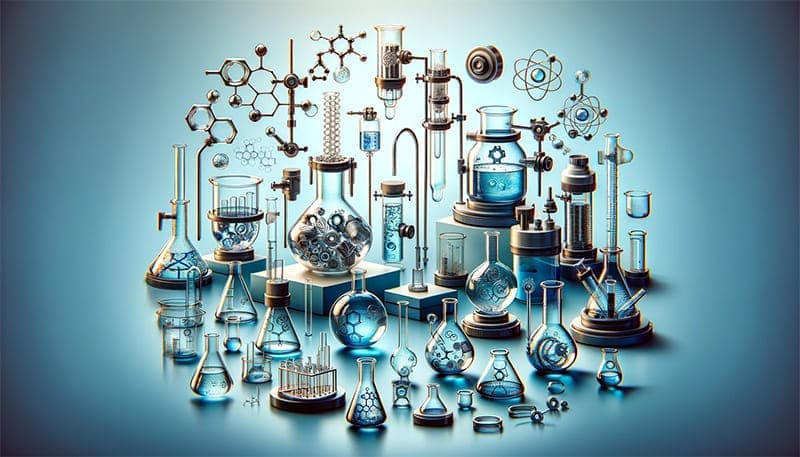
Customizing Glassware for Specific Needs
Sometimes, off-the-shelf glassware might not meet the specific needs of a complex reaction. Custom-designed glassware can be ordered, tailored to specific dimensions, shapes, and functionalities. This is particularly useful in specialized research and industrial applications.
Resources and Further Reading
For more detailed information on glassware types and their specific uses in chemical reactions, consult laboratory manuals or visit educational websites. Resources like WINSON offer comprehensive guides and tips for selecting and using laboratory glassware.
Conclusion
“Choosing the Right Glassware for Your Chemical Reactions: A Complete Guide” is your essential resource for navigating the complexities of laboratory glassware. Whether you’re a budding chemist, an experienced scientist, or a curious learner, this guide empowers you with the knowledge to make informed decisions. Embrace the art of precision in your experiments and elevate your scientific pursuits. Dive into the guide, enhance your understanding, and transform your chemical experimentation with the right glassware choices. Your journey to mastering laboratory practices starts here!


